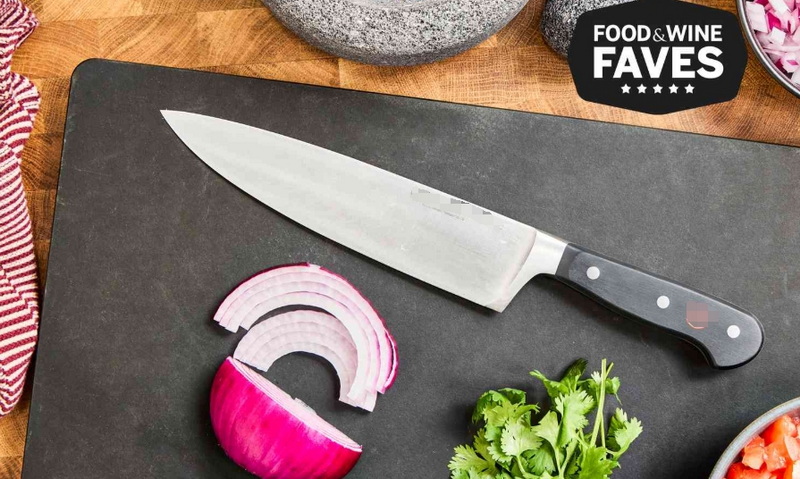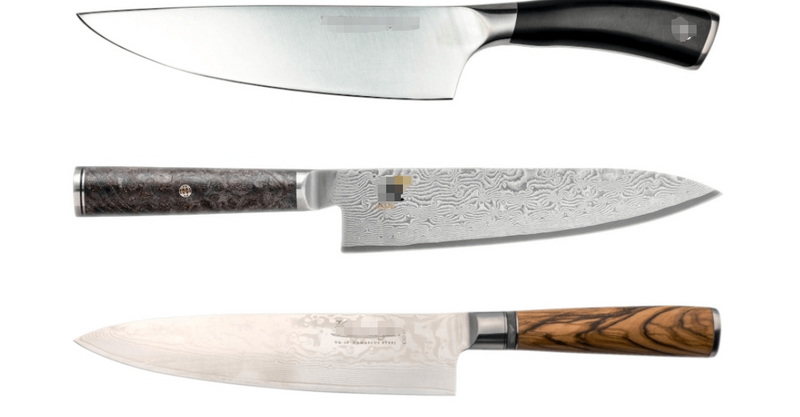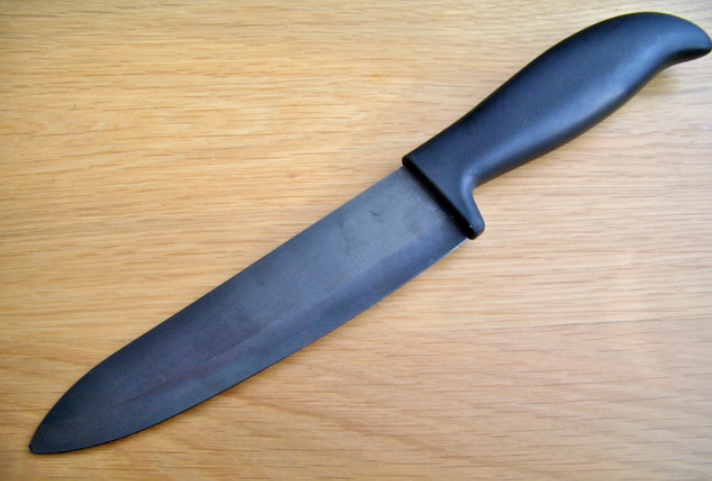

Views: 222 Author: Ella Publish Time: 2025-05-09 Origin: Site








Content Menu
● Introduction to Japanese Kitchen Knives
● The Top 10 Japanese Kitchen Knife Manufacturers
>> Tojiro
>> Miyabi
>> Global
>> Misono
>> Yoshihiro
>> Takeshi Saji
>> Mac Knives
● The Art and Science Behind Japanese Knives
● What Makes Japanese Knives Unique?
● Types of Japanese Kitchen Knives
● Choosing the Right Japanese Knife for Your Kitchen
● Japanese Knife Culture and Its Global Influence
● FAQ: Top 5 Questions About Japanese Kitchen Knives
>> 1. What is the difference between Japanese and Western kitchen knives?
>> 2. How do I choose the right Japanese knife for my needs?
>> 3. How should I care for my Japanese kitchen knife?
>> 4. Why are Japanese knives often more expensive than other knives?
>> 5. Can left-handed users use Japanese knives?
Japanese kitchen knives are revered worldwide for their precision, sharpness, and artistry. Rooted in centuries-old sword-making traditions, these knives have become the gold standard for both professional chefs and passionate home cooks. This comprehensive guide explores the top 10 kitchen knife manufacturers in Japan, highlighting their history, unique features, and what sets their blades apart. Along the way, you'll find a curated selection of images and videos to immerse yourself in the artistry and precision of Japanese knife-making.

Japanese kitchen knives are celebrated for their razor-sharp edges, lightweight feel, and meticulous craftsmanship. Unlike their Western counterparts, Japanese knives are often made with harder steel, allowing for thinner, sharper blades that excel at precision cutting. The legacy of Japanese bladesmiths dates back to samurai sword-making, and today's artisans continue to honor these techniques, blending tradition with innovation.
Japanese knives are more than just tools-they are extensions of a chef's hand, designed to enhance the cooking experience. Each knife is a testament to the dedication and skill of its maker, with every detail carefully considered for optimal performance.
Masamoto Sohonten is one of Japan's oldest and most respected knife makers, with a history dating back to 1845. Based in Tokyo, Masamoto is renowned for its dedication to traditional forging methods, producing knives that are highly prized by sushi chefs and culinary professionals. Their knives are known for exceptional sharpness, edge retention, and a perfect balance that feels natural in the hand.
Key Features:
- Hand-forged using high-carbon steel
- Wide range of traditional Japanese styles (yanagiba, deba, usuba)
- Preferred by top sushi chefs worldwide
Shun is a globally recognized brand produced by the KAI Group in Seki City, a region famous for its blade-making heritage. Shun knives are celebrated for their beauty, featuring Damascus-clad blades and elegant pakkawood handles. They combine the best of traditional Japanese craftsmanship with modern technology, resulting in knives that are both functional and visually stunning.
Key Features:
- VG-MAX and Damascus steel construction
- Hand-sharpened 16-degree edge
- Ergonomic handles for comfort and control
Sakai Takayuki knives are crafted in Sakai City, a region with over 600 years of knife-making tradition. These knives are revered for their hand-forged blades, exquisite finishing, and the use of both traditional and modern steels. Sakai Takayuki offers a wide variety of knives, from classic single-bevel Japanese blades to Western-style chef's knives.
Key Features:
- Handcrafted by master artisans
- Wide selection of blade styles and steels
- Favored by professional chefs for their sharpness and durability
Tojiro, based in Sanjo City, Niigata Prefecture, is known for producing high-quality knives at accessible price points. Tojiro knives are a favorite among both home cooks and professionals, offering exceptional performance without the premium price tag. The brand is also committed to transparency, with an open factory for visitors to witness the knife-making process.
Key Features:
- VG-10 and DP series for outstanding edge retention
- Double-bevel and single-bevel options
- Excellent value for quality
Miyabi combines Japanese artistry with German engineering, as it is owned by the Zwilling J.A. Henckels group but manufactured in Seki, Japan. Miyabi knives are known for their elegant designs, featuring intricate Damascus patterns and ice-hardened blades for superior strength and sharpness. The Honbazuke honing process ensures a razor-sharp edge straight from the box.
Key Features:
- Cryodur ice-hardening for durability
- Beautifully patterned blades
- Preferred by celebrity chefs
Global knives stand out for their modern, minimalist design and seamless stainless steel construction. Manufactured in Niigata, Japan, Global knives are lightweight, perfectly balanced, and feature a unique dimpled handle for a secure grip. The use of proprietary Cromova 18 stainless steel ensures excellent edge retention and resistance to rust and stains.
Key Features:
- All-stainless steel construction
- Lightweight and well-balanced
- Iconic dimpled handle for grip

Misono is a family-run company based in Seki City with over 750 years of tradition. Misono knives are known for their blend of Western and Japanese styles, offering both double-bevel and single-bevel blades. The UX-10 series is particularly celebrated for its edge retention and craftsmanship, making Misono a favorite among professional chefs.
Key Features:
- High-quality Swedish and Japanese steels
- Precision ground edges for sharpness
- Elegant and functional designs
Yoshihiro is a brand with over a century of history, specializing in handcrafted knives that blend traditional techniques with modern innovations. Each Yoshihiro knife is a work of art, offering a variety of blade and handle options to suit any chef's preference. The brand is highly regarded for its attention to detail and commitment to quality.
Key Features:
- Hand-forged using centuries-old techniques
- Wide range of blade styles and materials
- Customizable handles and finishes
Takeshi Saji is a master blacksmith from Echizen, a region famous for its cutlery. His knives are known for their unique designs, often featuring colored handles and intricate engravings. Each knife is handcrafted, blending traditional forging with creative artistry, making Takeshi Saji knives highly collectible and functional.
Key Features:
- Hand-forged by a renowned master
- Artistic designs with custom handles
- Exceptional sharpness and durability
Mac Knives, established in 1964, are popular among professional chefs for their razor-sharp edges and ease of maintenance. Made from high-quality molybdenum high-carbon steel, Mac knives feature a thin, lightweight profile that excels at precise slicing. The brand is known for its practical, user-friendly designs.
Key Features:
- Thin, sharp blades for precision
- Comfortable ergonomic handles
- Trusted by chefs worldwide
The creation of a Japanese kitchen knife is a harmonious blend of art and science. Master craftsmen, known as "Tosho," dedicate years-sometimes decades-to perfecting their skills. The process often begins with the selection of steel, which is crucial for determining the knife's hardness, sharpness, and durability.
The forging process involves heating, hammering, and folding the steel to remove impurities and create a strong, resilient blade. Some knives feature a core of high-carbon steel sandwiched between layers of softer steel, resulting in a blade that is both sharp and resistant to chipping. This technique, known as "San Mai," is a hallmark of many premium Japanese knives.
After forging, the blade is shaped, ground, and honed to achieve the desired edge geometry. Traditional knives often have a single-bevel edge, which allows for incredibly precise cuts, while modern knives may feature double-bevel edges for versatility. The final steps include polishing, attaching the handle, and meticulous quality control.
The beauty of Japanese knives is not only in their performance but also in their appearance. Many blades are adorned with intricate Damascus patterns, hand-engraved kanji, or unique handle materials such as magnolia wood, pakkawood, or even exotic hardwoods. Each knife is a unique piece of functional art.
Japanese kitchen knives are distinguished by several key features:
- Steel Quality: Japanese knives often use harder steels (like VG-10, Blue Steel, White Steel) for sharper, longer-lasting edges.
- Blade Geometry: Thinner, sharper blades allow for precise cuts and delicate work.
- Craftsmanship: Many Japanese knives are hand-forged by skilled artisans, preserving traditional methods.
- Aesthetics: From Damascus patterns to intricate engravings and custom handles, Japanese knives are as beautiful as they are functional.
- Single vs. Double Bevel: Traditional Japanese knives often have a single-bevel edge for specialized tasks, while many modern knives offer double-bevel edges for versatility.
These characteristics make Japanese knives highly sought after by chefs and collectors around the world.
Japanese kitchen knives come in a variety of shapes and sizes, each designed for specific tasks:
- Gyuto: The Japanese equivalent of a Western chef's knife, versatile for meat, fish, and vegetables.
- Santoku: A multipurpose knife with a shorter, wider blade, ideal for slicing, dicing, and mincing.
- Nakiri: A vegetable knife with a straight edge for clean, precise cuts.
- Yanagiba: A long, slender knife for slicing raw fish (sashimi).
- Deba: A heavy-duty knife for breaking down fish and poultry.
- Petty: A small utility knife for precision work.
- Usuba: A traditional vegetable knife with a single-bevel edge, favored by professional chefs for intricate vegetable carving.
Each type of knife is crafted to excel at its intended purpose, and choosing the right one can greatly enhance your cooking experience.
Selecting the perfect Japanese knife depends on your cooking style and needs. Here are some tips to help you choose:
- Assess Your Cooking Habits: If you prepare a wide range of dishes, a versatile gyuto or santoku is a great starting point. For vegetable-heavy cooking, consider a nakiri or usuba.
- Consider Blade Material: High-carbon steel blades offer exceptional sharpness but require more maintenance to prevent rust. Stainless steel options are easier to care for.
- Handle Comfort: Japanese knives come with various handle shapes and materials. Try different styles to find one that feels comfortable and secure in your hand.
- Blade Length: Choose a blade length that matches your comfort level and cutting tasks. Shorter blades offer more control, while longer blades are better for large ingredients.
- Budget: Japanese knives range from affordable to highly collectible. Set a budget and look for the best quality within your price range.
Investing in a quality Japanese knife can transform your kitchen experience, making meal preparation more efficient and enjoyable.
Japanese knives require proper care to maintain their sharpness and beauty:
- Hand Wash Only: Avoid dishwashers; hand wash and dry immediately to prevent rust.
- Use a Gentle Cutting Board: End-grain wood or soft plastic boards protect the blade.
- Regular Honing: Use a ceramic rod or whetstone to keep the edge sharp.
- Avoid Hard Materials: Do not cut bones, frozen foods, or hard shells to prevent chipping.
- Store Safely: Use a knife block, magnetic strip, or blade guard for storage.
- Periodic Sharpening: Even the best knives need occasional sharpening. Learn to use a whetstone or seek professional sharpening services.
Proper care ensures your knife will last for generations, retaining its sharpness and beauty.
The influence of Japanese kitchen knives extends far beyond Japan's borders. Renowned chefs around the world rely on Japanese blades for their precision and artistry. Culinary schools often teach students the importance of knife skills using Japanese knives, and home cooks increasingly seek out these tools for their kitchens.
Japanese knife makers have also inspired a new generation of artisans in other countries, leading to a global appreciation for traditional forging methods and meticulous craftsmanship. The blend of tradition and innovation continues to push the boundaries of what a kitchen knife can be.
In Japan, the culture surrounding knives is deeply rooted in respect and ritual. Many chefs have a personal connection to their knives, treating them with reverence and care. It is common for chefs to sharpen their own blades, viewing it as a meditative practice that connects them to their craft.
Japanese kitchen knives are the pinnacle of culinary tools, blending centuries-old tradition with modern innovation. Whether you're a professional chef or a home cook, investing in a quality Japanese knife can transform your cooking experience. The top 10 manufacturers featured here represent the best in Japanese craftsmanship, each offering unique styles and features to suit every need. By understanding the history, artistry, and care behind these blades, you can choose the perfect knife to elevate your culinary journey.

Japanese knives are typically lighter, thinner, and made from harder steel compared to Western knives. This allows for sharper edges and more precise cuts, but they can be more brittle and require careful handling. Western knives are heavier, thicker, and designed for durability, making them suitable for tougher tasks like cutting through bones.
Consider the types of food you prepare most often. For versatility, a gyuto or santoku is recommended. If you specialize in vegetables, a nakiri is ideal. For sushi and sashimi, choose a yanagiba. Also, consider handle style, blade length, and steel type.
Hand wash and dry your knife immediately after use. Use a soft cutting board and avoid cutting hard materials. Regularly hone the blade with a ceramic rod or whetstone, and store the knife safely in a block or on a magnetic strip. Avoid dishwashers and harsh detergents.
The price reflects the quality of materials, craftsmanship, and the time-consuming forging process. Many Japanese knives are handcrafted by skilled artisans using traditional methods, resulting in superior sharpness, edge retention, and aesthetics.
Many Japanese knives are made with a single-bevel edge for right-handed users, but left-handed versions are available. Double-bevel knives are suitable for both left- and right-handed users. Always check the product description or consult the manufacturer if you need a left-handed knife.